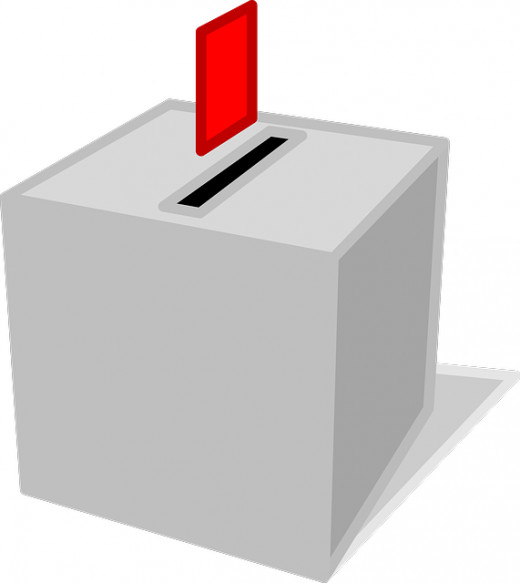The alternative voting system

The alternative voting system is an alternate form of voting to the first past the post system which is used commonly around the world. In preferential voting instead of voting for a single candidate you number the candidates from one to however many candidates there are. In the first round of voting, each candidates total number of number one votes are added up and the candidate with the least people who put a number one in their box gets eliminated. Then all of the people who had voted number one for the eliminated candidate have their votes redistributed with their votes now going to whoever they put a number two next to. Then the candidate with the next fewest number of number of total votes ( Both number 1 votes and number 2 votes from the first eliminated candidate) is eliminated and again their votes are redistributed based on who each voter numbered next on the list. This process continues until only two candidates remain. The end result is that everyone's vote eventually goes to one of the top two candidates, even if the candidate was the second last person the voter numbered.
It may be easier to think of it this way. To start with when votes are being counted, all votes are divided up into different piles based on who each voter put down as number one. The pile with the fewest number of votes then gets redistributed to the other piles based on who each person numbered next on their voting card. After the votes have been redistributed the piles are again counted and the pile with the least votes is again eliminated.
How to vote in an election using the alternative voting system
When voting in an election using the alternative voting system you will be presented with a voting card with a list of candidates on it and a box next to each candidates name. In order to vote all you need to do is number the boxes from one to however many candidates there are. You put a one next to the candidates name who you most want to be elected and the highest number against the person you least want to be elected. The person who you number last in your voting ticket will never received your vote.
For example if you are a Conservative. your voting ticket might look something like the one below. The below voting card is based on a fictional election and is not based on a real-world jurisdiction.
Candidate
| Preference
|
|---|---|
Martin Stalina (Communist Party)
| 5
|
Tony Shaw(Social democratic Party)
| 4
|
John Smith (Central party)
| 3
|
Greg Haven (Conservative party)
| 1
|
Patrick Price (Christian Conservative party)
| 2
|
As you can see the conservative voter voted for the two conservative parties first and then voted for the other parties based on which most closely aligned to his views even though it's likely he wouldn't favor any of them coming to power. Essentially what an alternative voting system does is ensure that the candidate who the least people don't like gets elected. Because even though this voter doesn't want the central party to get power, he would rather they win then Communist Party. Using the preferential voting system, his vote still counts for something despite the fact that he voted for a unsuccessful candidates first.
A mock election
In order to demonstrate how the alternative voting system working works, I'm going to create a mock election. In this mock election there are will be the same five candidates shown above and 10 voters. I am going to distribute votes and preferences randomly in order to create a realistic election scenario. Obviously a real election there will be more than 10 candidates however for the sake of the example let's pretend this is a really small district.
Voting
Candidate
| Voter 1
| Voter 2
| Voter 3
| Voter 4
| Voter 5
| Voter 6
| Voter 7
| Voter 8
| Voter 9
| Voter 10
| Voter 11
|
|---|---|---|---|---|---|---|---|---|---|---|---|
Martina Stalina (Communist party)
| 1
| 3
| 2
| 5
| 2
| 5
| 4
| 4
| 2
| 1
| 2
|
Tony Shaw (Social Democratic party)
| 2
| 1
| 1
| 2
| 1
| 4
| 5
| 5
| 3
| 4
| 3
|
John Smith (Central party)
| 4
| 2
| 3
| 1
| 5
| 3
| 3
| 1
| 5
| 3
| 1
|
Greg Haven (Conservative party)
| 3
| 5
| 5
| 3
| 4
| 2
| 1
| 3
| 4
| 2
| 4
|
Patrick Price (Christian Conservative party)
| 5
| 4
| 4
| 4
| 3
| 1
| 2
| 2
| 1
| 4
| 5
|
When you tally these votes you get the following results:
1st Round of counting
Party
| Votes
| |
|---|---|---|
Communist
| 2
| |
Social Democrat
| 3
| |
Centerist
| 3
| |
Conservative
| 1
| |
Christian Conservative
| 2
|
As you can see the social democratic party and centrist parties are currently leading with 3 votes and the conservative party came in last with 1 vote. Now, we eliminate the lowest candidate and redistribute his votes (In this case vote) to each voters second preference.
Round 2 of counting
Party
| Votes
| |
|---|---|---|
Communist
| 2
| |
Social Democrat
| 3
| |
Centerist
| 3
| |
Christian conservative
| 3
|
Now all parties are level except the communist party which gets eliminated and its 2 votes redistributed.
Round 3 of counting
Party
| Votes
| |
|---|---|---|
Social democrat
| 4
| |
Center
| 4
| |
Christian conservative
| 3
|
Now the Social Democrat and the Centrist are equal having both received 1 preference each from the Communist. Notice that Voter 10's second preference was actually the conservative but since he had already been eliminated his vote went to his third preference which was the Centrist. Now both of the Christian Conservative parties original votes will be redistributed along with the Conservative parties vote which had gone to the Christian conservative Party.
Round 4 of counting
Party
| Votes
| |
|---|---|---|
Social democrat
| 5
| |
Centerist
| 6
| |
So at the end of the day the centrist party won the election with 6 out of 11 votes. He got the Conservatives 1 vote and one of the Christian conservatives which was enough to hand him the win. Its worth noting that if one candidate had received more than 50% of the vote earlier they would automatically of been declared the winner because they would have been unbeatable. Had a first past the post system been in use rather than a alternative voting system the result would have been very different indeed.





![Election 2014: A Message to The Voters [249*9]](https://usercontent2.hubstatic.com/9226753_f120.jpg)

